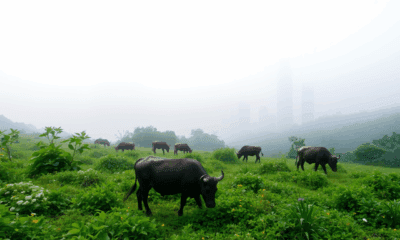While we try to keep things accurate, this content is part of an ongoing experiment and may not always be reliable.
Please double-check important details — we’re not responsible for how the information is used.
Earth & Climate
Predicting Damage from Local Earthquakes in Mexico City
Seismologists describe potential damage forecasts from ground shaking scenarios for moderate earthquakes in three regions of the Mexico City basin.

Atmosphere
Unpacking America’s Winter Puzzle: How the Stratosphere Shapes Extreme Cold Snaps
Even in a warming climate, brutal cold snaps still hammer parts of the U.S., and a new study uncovers why. High above the Arctic, two distinct polar vortex patterns — both distorted and displaced — play a major role in steering icy air toward different regions. One sends it plunging into the Northwest, while the other aims it at the Central and Eastern U.S. Since 2015, the westward version has been more common, bringing intensified cold to the Northwest in defiance of global warming trends. This stratospheric detective work offers fresh insight into extreme winter weather — and could supercharge long-range forecasts.
Earth & Climate
“Unveiling the Invisible: Scientists Capture High-Resolution Images of Wind-Wave Interactions on the Open Ocean”
A laser-equipped research platform has, for the first time, photographed airflow just millimeters above ocean waves, revealing two simultaneous wind–wave energy-transfer tricks—slow short waves steal power from the breeze, while long giants sculpt the air in reverse. These crisp observations promise to overhaul climate and weather models by clarifying how heat, momentum, and greenhouse gases slip between sea and sky.
Diabetes
The Hidden Cost of Climate Change: A Threat to Food Quality and Human Health
Climate change is silently sapping the nutrients from our food. A pioneering study finds that rising CO2 and higher temperatures are not only reshaping how crops grow but are also degrading their nutritional value especially in vital leafy greens like kale and spinach. This shift could spell trouble for global health, particularly in communities already facing nutritional stress. Researchers warn that while crops may grow faster, they may also become less nourishing, with fewer minerals, proteins, and antioxidants raising concerns about obesity, weakened immunity, and chronic diseases.
-

 Detectors3 months ago
Detectors3 months agoA New Horizon for Vision: How Gold Nanoparticles May Restore People’s Sight
-

 Earth & Climate4 months ago
Earth & Climate4 months agoRetiring Abroad Can Be Lonely Business
-

 Cancer4 months ago
Cancer4 months agoRevolutionizing Quantum Communication: Direct Connections Between Multiple Processors
-

 Agriculture and Food4 months ago
Agriculture and Food4 months ago“A Sustainable Solution: Researchers Create Hybrid Cheese with 25% Pea Protein”
-

 Diseases and Conditions4 months ago
Diseases and Conditions4 months agoReducing Falls Among Elderly Women with Polypharmacy through Exercise Intervention
-

 Chemistry4 months ago
Chemistry4 months ago“Unveiling Hidden Patterns: A New Twist on Interference Phenomena”
-

 Albert Einstein4 months ago
Albert Einstein4 months agoHarnessing Water Waves: A Breakthrough in Controlling Floating Objects
-

 Earth & Climate4 months ago
Earth & Climate4 months agoHousehold Electricity Three Times More Expensive Than Upcoming ‘Eco-Friendly’ Aviation E-Fuels, Study Reveals





























